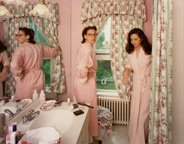Staging
 What stylistic and staging challenges do you face? How does music (where applicable) influence dramatic action?
What stylistic and staging challenges do you face? How does music (where applicable) influence dramatic action?Using popular music and some classical music in my plays makes me nervous because it has such a potential to derail a well staged moment. People are fickle and varied in their emotional responses and I have no talent for guessing what kind of song might aid or hamper my play in an audience’s eyes (or ears). Original music or sound compositions can be effective in creating mood and even in framing threads of action within a play. In fact, sound often weighs in heavily when I first consider staging. During early staging rehearsals, I try to find a specific physical vocabulary for the piece by creating a series of movements, gestures, sounds, or tempos unique to the play. This is my favorite part of the entire process. I use my background in design and treat blocking as if I were making ten thousand paintings with my actors. These paintings, in every play, are in turn linked together by a unique physical signature.
 The Cherry Orchard contains a lot of information in the text, facts and details that carry enormous weight in terms of the overall emotional impact of the piece. Extraneous movement complicates the actor’s task of simply delivering the information clearly. On the other hand, The Cherry Orchard is a long play and can feel even longer if each moment is not staged in a crisp and active way. So, the challenge is to find the balance between still and active---precise and spontaneous.
The Cherry Orchard contains a lot of information in the text, facts and details that carry enormous weight in terms of the overall emotional impact of the piece. Extraneous movement complicates the actor’s task of simply delivering the information clearly. On the other hand, The Cherry Orchard is a long play and can feel even longer if each moment is not staged in a crisp and active way. So, the challenge is to find the balance between still and active---precise and spontaneous. Tiny climaxes occur throughout the script and attention to focus in each stage picture is essential to punctuate these moments. One of my biggest influences is a photographer named Tina Barney, mainly because she creates enormous tension in her work by choosing what her viewer sees first in each shot and how their eye travels over the rest of the photograph. On the page she creates a clear primary focal point that the viewer’s eye moves to immediately, then she draws the eye to a secondary point of focus. This secondary focal point either alters or directly contradicts first impressions about her work. In other words, her harmless looking family photos have --- subtext. If we look a little longer we will see something more penetrating, something that is offbeat, hidden and vastly disturbing. Applying this concept to a play is tricky but possible.
Tiny climaxes occur throughout the script and attention to focus in each stage picture is essential to punctuate these moments. One of my biggest influences is a photographer named Tina Barney, mainly because she creates enormous tension in her work by choosing what her viewer sees first in each shot and how their eye travels over the rest of the photograph. On the page she creates a clear primary focal point that the viewer’s eye moves to immediately, then she draws the eye to a secondary point of focus. This secondary focal point either alters or directly contradicts first impressions about her work. In other words, her harmless looking family photos have --- subtext. If we look a little longer we will see something more penetrating, something that is offbeat, hidden and vastly disturbing. Applying this concept to a play is tricky but possible.
Tempo is an underused element of design. Often in rehearsals I find explosive moments of clarity by using altered tempos within a beat. Having two actors moving simultaneously but at different tempos can create a powerful sense of focus and conflict within a scene. It allows moments that would normally split an audience’s focus to resonate the way Tina Barney’s still photos do.
In staging The Cherry Orchard, the ideas discussed above represent the beginnings of what will eventually become a clear physical vocabulary for my actors to incorporate.


0 Comments:
Post a Comment
<< Home